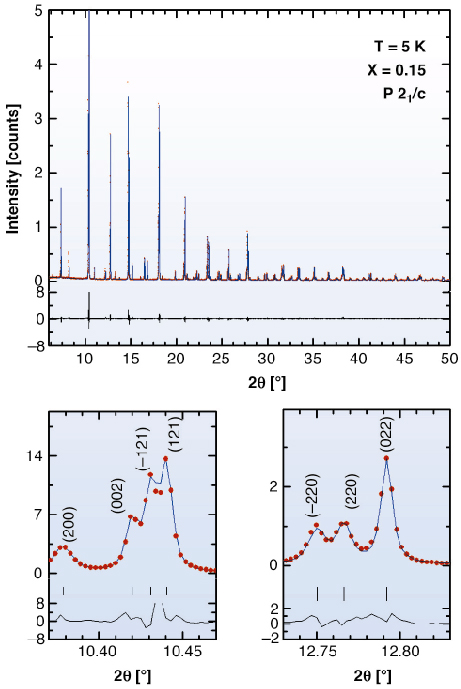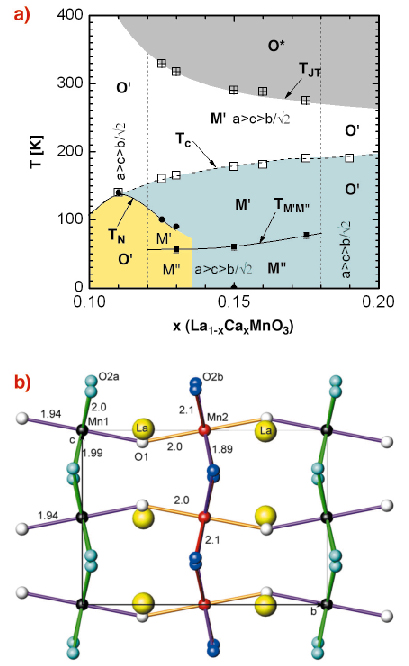- Home
- Users & Science
- Scientific Documentation
- ESRF Highlights
- ESRF Highlights 2005
- Materials Science
- Crystal Structure of Ferromagnetic Insulated La1-xCaxMnO3
Crystal Structure of Ferromagnetic Insulated La1-xCaxMnO3
Crystal Structure of Ferromagnetic Insulated La<sub>1-x</sub>Ca<sub>x</sub>MnO<sub>3</sub>
The manganese perovskites (L1-xAxMnO3 , where L is rare earth and A is alkaline earth) provide an ideal physical system for the elucidation of a variety of fundamental physical questions related with the magnetic, electronic and structural properties of condensed matter in a strongly-correlated electronic system [1]. The most important topic to emerge from studies of manganites’ physics is the competition between localising and delocalising effects in close connection with lattice, spin and charge degrees of freedom. The ferromagnetic metallic ground state has been partially explained, with consideration of a double exchange mechanism. However, the nature of the ferromagnetic insulating state (FMI) in lightly doped La1-xAxMnO3 (A = Sr, Ca, x = 0.1-0.2) manganese perovskites continues to offer significant challenges for the understanding of the physical properties of these materials. Typically, insulating compounds of this category are antiferromagnetic, and ferromagnetism is associated with a metallic behaviour that arises from doping and double exchange. The FMI state can be achieved with a certain orbital ordering, favourable for ferromagnetism [2].
The interplay of orbital, charge, spin and lattice degrees of freedom in these materials produces small structural changes, in comparison to the high temperature structure. Consequently, high-resolution X-ray diffraction data, in stoichiometric samples are necessary. The required resolution is offered by the high-resolution powder diffractometer of beamline ID31.
We have studied the crystal and magnetic structures of the La1-xCaxMnO3 compound for (0.11≤ x ≤ 0.175) using stoichiometric samples. La1-xAxMnO3 samples were prepared by thoroughly mixing high-purity stoichiometric amounts of CaCO3, La2O3, and MnO2. The mixed powders reacted in air at temperatures up to 1400°C, for several days, with intermediate grinding. Finally, the samples were slowly cooled to 25°C. These samples are cation deficient [3]. In order to produce stoichiometric samples, additional annealing in a He atmosphere was used.
 |
|
Fig. 48: Rietveld plot of La0.85Ca0.15MnO3 compound at T = 5K. The experimental pattern was measured with the high-resolution diffractometer (wavelength 0.05 nm) on ID31. Shown are details of the diffraction peaks where the characteristic peak splitting compatible with P21/c space group is expected. |
For x < 0.13 the ground state is insulating canted antiferromagnetic. Thanks to the excellent resolution of ID31, we discovered that the high temperature (Pnma) crystal structure undergoes a monoclinic distortion for 0.13 ≤ x ≤ 0.175, below the Jahn-Teller transition temperature (TJT). Figure 48 shows a representative Rietveld plot for La0.85Ca0.15MnO3 sample at T = 5 K. The crystal structure can be described with the P21/c space group, which contains two Mn sites. The unit cell strain parameter s = 2(a-c)/(a+c) increases for T < TJT, taking the maximum value at the Curie point, and then decreases. Below TM/M// ~ 60 K, s abruptly changes slope and finally approaches T = 0 K with nearly zero slope (Figure 49a). The change of s at TM/M// is connected to a characteristic feature in the magnetic measurements. As x increases towards the ferromagnetic metallic boundary, the monoclinic structure is preserved although s is reduced appreciably. The low temperature monoclinic structure contains two distinct Mn sites (Figure 49b) and in relation with the Mn-O bond lengths one could consider that a specific orbital ordering takes place in the ferromagnetic insulating regime. Using the Kanamori- Goodenough-Anderson rules, a reasonable interpretation of the ferromagnetic insulating ground state can be given.
 |
|
Fig. 49: (a) Ferromagnetic insulating part of the phase diagram of La1-xCaxMnO3 compound. The light yellow region corresponds to the canted-antiferromagnetic regime, and the light blue to the ferromagnetic-insulating regime. The symbols O*, O/, O//, M/ and M// have the following meaning: O* orthorhombic Pnma symmetry with c > a > b / |
References
[1] Colossal Magnetoresistive Oxides, edited by Y. Tokura, Gordon and Breach, New York, 200; Colossal Magnetoresistance; Charge Ordering and Related Properties of Manganese Oxides, edited by C. N. R. Rao and B. Raveau World Scientific, Singapore, (1998).
[2] D. Khomskii and G. Sawatzky, Solid State Comm. 102, 87 (1997).
[3] M. Pissas and G. Papavassiliou J. Phys.: Condens. Matter 16 6527 (2004).
Principal Publication and Authors
M. Pissas (a), I. Margiolaki (b), G. Papavassiliou (a), D. Stamopoulos (a), D. Argyriou (c), Phys. Rev B 72, 064425 (2005).
(a) Institute of Materials Science, National Center for Scientific Research, Athens (Greece)
(b) ESRF
(c) Berlin Neutron Scattering Center, Hahn-Meitner-Institut (Germany)



